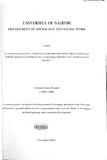| dc.description.abstract | The number of OVCs in Kenya is not known partly because of lack of a common country
defmition of OVC, especially identifying what constitutes a 'vulnerable' child. Different sources
have continued to use an estimation of 2.4 million orphans exposed to risk
s of poverty, stigma,
poor health and nutrition, limited educational and vocational opportunities, and inadequate social
and emotional support. The study was set out to establish the effectiveness of CBOs in providing
care and support for Orphans and Vulne
rable Children within three CBOs in Kisumu East
District. This was done through reviewing of implementation of OVC programme strategies by
Orongo Widows and Orphans, Manyenya Upendo and Maisha CBO. The selection of the district
and CBOs was done purposivel
y and data was gathered through focus group discussions and
unstructured interviews. Data analysis was carried out through establishing the emerging themes
and comparing responses by respondents in order to check the validity of the data collected.
OVC int
erventions at community level, whether initiated by individuals or groups, offer various
types of support including material and non
-
material assistance to vulnerable children and their
households. This support includes food and nutrition support, educatio
nal support, psychosocial
support, household visits and home
-
based care and child fostering. A community response may
not necessarily offer a tangible resource or service; the intangible support includes counseling,
companionship, acceptance and solace thr
ough prayer as well as help to destigmatize community
members. Community initiatives, built on a spirit of volunteerism and a willingness to help
others, are of various types and can be at different stages of development within the same
community. Unlike O
rongo and Manyenya, Maisha seemed to have a weak sense of common
community initiatives which was characterized by low levels of togetherness, trust and
reciprocity. An examination of factors facilitating or hindering responses by a community looked
at both
individual and social factors, because some individuals volunteer despite facing problems
such as poverty and unemployment. Social factors hindering community responses may include
Age, gender, HIV and AIDS
-
related stigma. Linkage to education, health and
welfare services
available locally if strengthened will reduce the work load of the CBO and therefore more
children can be reached. The relationship between government and community responses can be
reciprocal, with government providing financial and tech
nical support to CBOs and the CBOs
implementing programmes and reaching out to the OVC in return. The general conclusion from
this study was that commendable efforts had been made in OVC interventions and therefore
CBOs have a great potential towards the a
chievement of sustainable development, however more
emphasis should be laid on meeting the priority needs of the OVC and their Care givers. The
CBOs also need to constantly review their service delivery strategy and approach for effective
interventions | |

